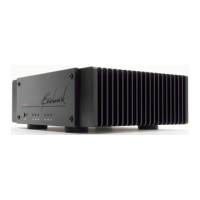AHB2 Instruction Manual Rev F Page 39
Low Gain – The AHB2 has a low gain setting that optimizes the gain structure of
professional monitoring systems. Maximum rated output is reached at an input signal level
of 22 dBu. This places the upstream equipment in an ideal operating range to maximize the
SNR of the monitoring chain. Most power amplifiers have far too much gain, and this
degrades noise performance of the overall system. To provide compatibility with lower input
signal levels, the AHB2 has an ultra low-noise input amplifier with a 3-prosition gain switch.
The upper two settings boost the gain to allow direct interfacing with Hi-Fi components that
typically operate at lower signal levels than those produced by professional components.
Passive Cooling – The sonic performance of the AHB2 would be impossible to appreciate
if it had a motor-driven fan. There are no noise-generating fans to detract from the total
silence of the AHB2. Experience every detail of your favorite recordings without the
masking effects of fan noise.
Resonant Switch-Mode Power Supply – Most high-end power amplifiers use unregulated
linear power supplies. The conventional wisdom is that linear supplies are electrically quieter
than switching supplies. Benchmark's research shows that this is a myth. Linear supplies
have transformers that operate at the AC mains frequency. The problem with these 50 to 60
Hz transformers is that they must be very large in order to supply the required power.
These large low-frequency transformers generate large stray magnetic fields that can
interfere with other nearby devices, and with the amplifier itself. The noise performance of
many traditional power amplifiers is limited by the amplitude of the AC line-related hum.
This hum is often magnetically induced and is very hard to eliminate. To solve these
problems, Benchmark now uses switching power supplies in all of its newer products.
Switching frequencies are set well above the audio band. More importantly, the high
switching frequency greatly reduces the size of the magnetic components and the
magnitude of the stray magnetic fields. Resonant switching is used in the AHB2 to minimize
switching noise. Resonant supplies switch at low voltage and low current and are much
quieter than traditional switching supplies.
Regulated Power Supply - Audio amplifiers usually use unregulated supplies. The theory
is that the amplifier can produce higher peak output power for a given power supply size.
Linear regulation would throw away power that could be delivered to the output devices.
Benchmark's move to switching supplies changes the efficiency equations. Switching
supplies can produce a regulated output without wasting power and without creating
unwanted heat. A further advantage of regulation is that the output voltage is not a function
of AC line voltage, prior audio content, or speaker loading. The switching supply in the
AHB2 responds to bass frequencies, maintains a constant low-ripple output voltage, and
delivers very predictable output power.
Low Stored Energy - Most audio power amplifiers rely on a bank of large capacitors for
energy storage. These capacitors remove some of the ripple produced by an unregulated
linear supply, and help reduce supply sag in order to maintain a high output level
immediately following musical peaks. Unfortunately, these capacitors also slow down the
recovery from voltage sag due to peak loading. Benchmark's approach is to nearly eliminate
all storage after the power supply. The power supply regulation takes the place of energy
storage, responds quickly to peak loading, maintains very low ripple voltage, and provides
immunity to AC line-voltage fluctuations.
Digital Protection Systems - The AHB2 has a digital control system that monitors all of
the critical functions in order to provide comprehensive protection from overload and fault
conditions. Many of these systems do not exist in traditional designs.

